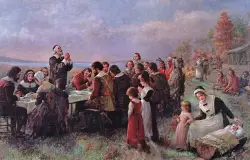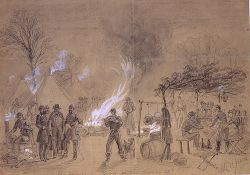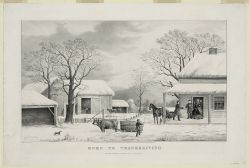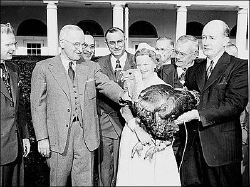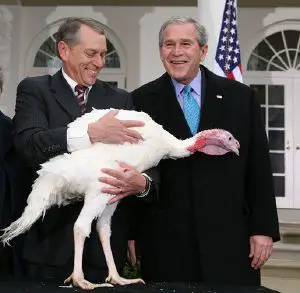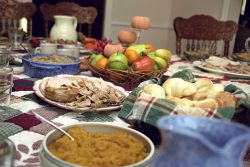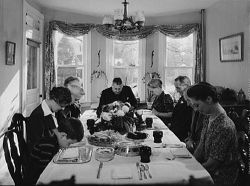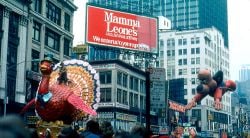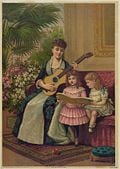Thanksgiving
| Thanksgiving Day | |
|---|---|
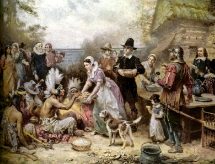
| |
| Observed by | Canada, United States |
| Type | National |
| Date | 2nd Monday in October (Canada) 4th Thursday in November (U.S.) |
Thanksgiving Day is a harvest festival. Traditionally, it is a time to give thanks for the harvest and express gratitude in general. It is a holiday celebrated primarily in the United States and Canada. While originally religious, Thanksgiving is now primarily identified as a secular holiday albeit of historical, legendary, and symbolic significance.
The date and location of the first Thanksgiving celebration is a topic of modest contention. Though the earliest attested Thanksgiving celebration was on September 8, 1565 in what is now Saint Augustine, Florida, the traditional "first Thanksgiving" is venerated as having occurred at the site of Plymouth Plantation, in 1621, shared with the Native Americans. There was also an early "day of thanksgiving" recognizing the arrival of 38 English settlers at Berkeley Hundred on the James River, Virginia, on December 4, 1619.
Today, Thanksgiving is celebrated on the fourth Thursday of November in the United States and on on the second Monday of October in Canada. In America, Thanksgiving dinner is held on this day, usually as a gathering of family members and friends. It is a day for watching football games, parades, and television specials. Thanksgiving also marks the beginning of the Christmas shopping season. Thus, just as the history of the early settlers in North America reflects both self-interest and the guidance of God, the celebration of Thanksgiving has come to be equally mixed. Nevertheless, this holiday provides a valuable opportunity for the strengthening of family bonds, expressions of gratitude, and, at least for some, a reminder of the hopes and struggles of both those who already inhabited this land and those who sailed from Europe as new settlers.
Introduction
Thanksgiving or Thanksgiving Day had its origins in a harvest festival to thank God for the bounty of the autumn harvest. Celebrated most notably in the United States but also found in many other nations, Thanksgiving is a symbol of the love and joy people feel towards God for the grace and blessings has bestowed on them throughout the year and at harvest time, in particular.
As a liturgical festival, Thanksgiving corresponds to the English and continental European Harvest festival. On the Sunday of Thanksgiving weekend churches are decorated with cornucopias, pumpkins, corn, wheat sheaves, and other harvest bounty, English and European harvest hymns are sung, and scriptural selections drawn from biblical stories relating to the Jewish harvest festival of Sukkot are read.
Thanksgiving involves gratitude not only to God but also one's community members. It is also about reaping the benefits of the year's work, efforts, and struggles. The traditional Thanksgiving feast shared among family, friends, and the extended community is a significant gathering that reinforces the founding concepts of the celebration. Partaking in the customary Thanksgiving turkey and accompanying dishes symbolizes partaking in the bounty of the harvest.
United States
Thanksgiving celebrated on the fourth Thursday in November, at the end of the harvest season, is an annual American Federal holiday to express thanks for one's material and spiritual possessions. Though the holiday's origins can be traced to harvest festivals which have been celebrated in many cultures since ancient times, for many the American holiday has religious undertones related to the deliverance of the English settlers by Native Americans after the brutal winter at Plymouth, Massachusetts.
Some of the details of the American Thanksgiving story are myths that developed in the 1890s and early 1900s as part of the effort to forge a common national identity in the aftermath of the Civil War and in the melting pot of new immigrants.
History
Spaniards
The first recorded Thanksgiving ceremony took place on September 8, 1565, when 600 Spanish settlers, under the leadership of Pedro MenĂŠndez de AvilĂŠs, landed at what is now St. Augustine, Florida, and immediately held a Mass of Thanksgiving for their safe delivery to the New World; there followed a feast and celebration.[1]
The Spanish colonial town of San Elizario (San Elceario), near El Paso, Texas, has also been said to be the site of an early Thanksgiving held in what is now known as the United States, though that was not a harvest festival. Don Juan de OĂąate ordered his expedition party to rest and conducted a mass in celebration of thanksgiving on April 30, 1598.[2]
The Virginia colony
On December 4, 1619, 38 English settlers arrived at Berkeley Hundred, on the north bank of the James River near Herring Creek, in an area then known as Charles Cittie. The location was about 20 miles upstream from Jamestown, where the first permanent settlement of the Colony of Virginia had been established on May 14, 1607.
The group's charter required that the day of arrival be observed yearly as a "day of thanksgiving" to God. On that first day, Captain John Woodleaf held the service of thanksgiving:
We ordaine that the day of our ships arrival at the place assigned for plantacon in the land of Virginia shall be yearly and perpetually keept holy as a day of thanksgiving to Almighty God.[3]
During the Indian Massacre of 1622, nine of the settlers at Berkeley Hundred were killed, as well as about a third of the entire population of the Virginia Colony. The Berkeley Hundred site and other outlying locations were abandoned as the colonists withdrew to Jamestown and other more secure points.
After several years, the site became Berkeley Plantation, and was long the traditional home of the Harrison family, one of the First Families of Virginia. Berkeley Plantation continues to be the site of an annual Thanksgiving event to this day. President George W. Bush gave his official Thanksgiving address in 2007 at Berkeley:
In the four centuries since the founders of Berkeley first knelt on these grounds, our nation has changed in many ways. Our people have prospered, our nation has grown, our Thanksgiving traditions have evolvedâafter all, they didn't have football back then. Yet the source of all our blessings remains the same: We give thanks to the Author of Life who granted our forefathers safe passage to this land, who gives every man, woman, and child on the face of the Earth the gift of freedom, and who watches over our nation every day.[4]
The Pilgrims at Plymouth
The Pilgrims set apart a day to celebrate at Plymouth immediately after their first harvest, in 1621. They shared their feast with members of the Wampanoag tribe, Squanto, a Patuxet Native American who resided with the Wampanoag tribe, having taught the Pilgrims how to catch eel and grow corn as well as serving as an interpreter for them (Squanto had learned English as a slave in Europe and travels in England). At the time this celebration was not regarded as a Thanksgiving observance; harvest festivals were existing parts of English and Wampanoag tradition alike. Several colonists have personal accounts of the 1621 feast in Plymouth, Massachusetts.
William Bradford wrote in Of Plymouth Plantation:
They began now to gather in the small harvest they had, and to fit up their houses and dwellings against winter, being all well recovered in health and strength and had all things in good plenty. For as some were thus employed in affairs abroad, others were exercised in fishing, about cod and bass and other fish, of which they took good store, of which every family had their portion. All the summer there was no want; and now began to come in store of fowl, as winter approached, of which this place did abound when they came first (but afterward decreased by degrees). And besides waterfowl there was great store of wild turkeys, of which they took many, besides venison, etc. Besides, they had about a peck a meal a week to a person, or now since harvest, Indian corn to the proportion. Which made many afterwards write so largely of their plenty here to their friends in England, which were not feigned but true reports.[5]
Edward Winslow wrote in Mourt's Relation:
Our harvest being gotten in, our governor sent four men on fowling, that so we might after a special manner rejoice together after we had gathered the fruits of our labor. They four in one day killed as much fowl as, with a little help beside, served the company almost a week. At which time, amongst other recreations, we exercised our arms, many of the Indians coming amongst us, and among the rest their greatest king Massasoit, with some ninety men, whom for three days we entertained and feasted, and they went out and killed five deer, which we brought to the plantation and bestowed on our governor, and upon the captain and others. And although it be not always so plentiful as it was at this time with us, yet by the goodness of God, we are so far from want that we often wish you partakers of our plenty.[6]
The Pilgrims did not hold a true Thanksgiving until 1623, when it followed a drought, prayers for rain, and a subsequent rain shower. Irregular Thanksgivings continued after favorable events and days of fasting after unfavorable ones. In the Plymouth tradition, a thanksgiving day was a church observance, rather than a feast day.
Gradually, an annual Thanksgiving after the harvest developed in the mid-seventeenth century. This did not occur on any set day or necessarily on the same day in different colonies in America.
The Massachusetts Bay Colony established in 1628 near present day Boston (consisting mainly of Puritan Christians, who had very different religious beliefs from the Pilgrims) celebrated Thanksgiving for the first time in 1630, and frequently thereafter until about 1680, when it became an annual festival in that colony; and Connecticut as early as 1639 and annually after 1647, except in 1675. The Dutch in New Netherland appointed a day for giving thanks in 1644 and occasionally thereafter.
During the eighteenth century, individual colonies commonly observed days of thanksgiving throughout each year in honor of a military victory, an adoption of a state constitution, or an exceptionally bountiful crop. A traditional Thanksgiving Day from that period was not a day marked by plentiful food and drink as is today's custom, but rather a day set aside for prayer and fasting.
The Revolutionary War to nationhood
During the American Revolutionary War the Continental Congress appointed one or more thanksgiving days each year, each time recommending to the executives of the various states the observance of these days in their states.
The First National Proclamation of Thanksgiving was given by the Continental Congress in 1777:
It is therefore recommended to the legislative or executive Powers of these UNITED STATES to set apart THURSDAY, the eighteenth Day of December next, for SOLEMN THANKSGIVING and PRAISE: That at one Time and with one Voice, the good People may express the grateful Feelings of their Hearts, and consecrate themselves to the Service of their Divine Benefactor; and that, together with their sincere Acknowledgments and Offerings, they may join the penitent Confession of their manifold Sins, whereby they had forfeited every Favor; and their humble and earnest Supplication that it may please GOD through the Merits of JESUS CHRIST, mercifully to forgive and blot them out of Remembrance; That it may please him graciously to afford his Blessing on the Governments of these States respectively, and prosper the public Council of the whole.[7]
George Washington, leader of the revolutionary forces in the American Revolutionary War, proclaimed a Thanksgiving in December 1777 as a victory celebration honoring the defeat of the British General Burgoyne at Saratoga.
As President, on October 3, 1789, George Washington proclaimed and created the first Thanksgiving Day designated by the national government of the United States of America:
Whereas it is the duty of all Nations to acknowledge the providence of Almighty God, to obey his will, to be grateful for his benefits, and humbly to implore his protection and favor, and whereas both Houses of Congress have by their joint Committee requested me "to recommend to the People of the United States a day of public thanksgiving and prayer to be observed by acknowledging with grateful hearts the many signal favors of Almighty God especially by affording them an opportunity peaceably to establish a form of government for their safety and happiness.[8]
George Washington again proclaimed a Thanksgiving in 1795.
President John Adams declared Thanksgivings in 1798 and 1799. No Thanksgiving proclamations were issued by Thomas Jefferson but James Madison renewed the tradition in 1814, in response to resolutions of Congress, at the close of the War of 1812. Madison also declared the holiday twice in 1815; however, none of these were celebrated in autumn. In 1816, Governor Plamer of New Hampshire appointed Thursday, November 14 to be observed as a day of Public Thanksgiving and Governor Brooks of Massachusetts appointed Thursday, November 28 to be observed throughout the state as a day of Thanksgiving.
A thanksgiving day was annually appointed by the governor of New York from 1817. In some of the Southern states there was opposition to the observance of such a day on the ground that it was a relic of Puritanic bigotry, but by 1858 proclamations appointing a day of thanksgiving were issued by the governors of 25 states and two territories.
Lincoln and the Civil War
In the middle of the American Civil War, President Abraham Lincoln, prompted by a series of editorials written by Sarah Josepha Hale, proclaimed a national Thanksgiving Day, to be celebrated on the final Thursday in November 1863:
I do therefore invite my fellow citizens in every part of the United States, and also those who are at sea and those who are sojourning in foreign lands, to set apart and observe the last Thursday of November next, as a day of Thanksgiving and Praise to our beneficent Father who dwelleth in the Heavens. And I recommend to them that while offering up the ascriptions justly due to Him for such singular deliverances and blessings, they do also, with humble penitence for our national perverseness and disobedience, commend to his tender care all those who have become widows, orphans, mourners or sufferers in the lamentable civil strife in which we are unavoidably engaged, and fervently implore the interposition of the Almighty Hand to heal the wounds of the nation and to restore it as soon as may be consistent with the Divine purposes to the full enjoyment of peace, harmony, tranquility and Union.[9]
Since 1863, Thanksgiving has been observed annually in the United States.
1939 to 1941
Abraham Lincoln's successors as president followed his example of annually declaring the final Thursday in November to be Thanksgiving. But in 1939, President Franklin D. Roosevelt broke with this tradition. November had five Thursdays that year, and Roosevelt declared the fourth Thursday (November 23) as Thanksgiving rather than the fifth one. In 1940, in which November had four Thursdays, he declared the third one as Thanksgiving. With the country still in the middle of the Great Depression, Roosevelt thought an earlier Thanksgiving would give merchants a longer period to sell goods before Christmas. Increasing profits and spending during this period, Roosevelt hoped, would help bring the country out of the Depression. At the time, advertising goods for Christmas before Thanksgiving was considered inappropriate.
There was much upheaval and protest over this new date, causing some to deride the holiday as "Franksgiving"âa portmanteau of Franklin and Thanksgiving. However, since a presidential declaration of Thanksgiving Day was not legally binding, it was widely disregarded. Twenty-three states went along with Roosevelt's recommendation, 22 did not, and some, like Texas, took both weeks as government holidays. However, no significant increase in retail sales was found as a result of the earlier date, and Roosevelt prepared to return Thanksgiving to the traditional day in 1942.
1941 to present
The U.S. Congress in 1941 passed a bill requiring that Thanksgiving be observed annually on the fourth Thursday of November, which was sometimes the last Thursday and sometimes (less frequently) the next to last. On December 26 of that year President Roosevelt signed this bill, for the first time making the date of Thanksgiving a matter of federal law.
The National Turkey Federation has developed the practice of presenting the President of the United States with one live turkey and two dressed turkeys, in a ceremony known as the National Thanksgiving Turkey Presentation. The live turkey is pardoned and lives out the rest of its days on a peaceful farm.
Traditional celebrations
U.S. tradition compares the holiday with a meal held in 1621 by the Wampanoag and the Pilgrims who settled in Plymouth, Massachusetts. This element continues in modern times with the Thanksgiving dinner, often featuring turkey, playing a large role in the celebration of Thanksgiving. Most people celebrate by gathering at home with family or friends for a holiday feast.
Certain kinds of food are traditionally served at Thanksgiving meals. First and foremost, baked or roasted turkey is usually the featured item on any Thanksgiving feast table (so much so that Thanksgiving is sometimes referred to as "Turkey Day"). Stuffing, mashed potatoes with gravy, sweet potatoes, cranberry sauce, sweet corn, other fall vegetables, and pumpkin pie are commonly associated with Thanksgiving dinner. All of these primary dishes are native to the Americas or were introduced as a new food source to the Europeans when they arrived.
As well as meals at home for family and friends, Thanksgiving is a time of concern for the whole community. To feed the needy, most communities have annual food drives that collect non-perishable packaged and canned foods, and corporations sponsor charitable distributions of staple foods and Thanksgiving dinners.
Giving thanks
Thanksgiving was originally a religious observance for all the members of the community to give thanks to God for a common purpose. Historic reasons for community thanksgivings include the 1541 thanksgiving mass after the expedition of Coronado safely crossing part of Texas and finding game,[11] And the December 18, 1777 thanksgiving after the victory in the revolutionary battle of Saratoga.[12] In his 1789 Proclamation, President Washington gave many noble reasons for a national Thanksgiving, including âfor the civil and religious liberty,â for âuseful knowledge,â and for Godâs âkind careâ and "His Providence."[13] A specifically Christian focus was included in the proclamations of Grover Cleveland in 1896[14] and William McKinley, in 1900.[15] Several other presidents have cited the Judeo-Christian tradition.
The tradition of giving thanks to God is continued today in various forms. Religious and spiritual organizations offer services and events on Thanksgiving themes the week-end before, the day of, or the week-end after Thanksgiving.
In celebrations at home, it is a holiday tradition in many families to begin the Thanksgiving dinner by saying grace. Found in diverse religious traditions, grace is a prayer before or after a meal to express appreciation to God, to ask for Godâs blessing, or in some philosophies, to express an altruistic wish or dedication. The grace may be led by the hostess or host, as has been traditional, or, in contemporary fashion, each person may contribute words of blessing or thanks in their own style.[16]
In popular culture
Parades
In 1920, Gimbels department store in Philadelphia staged a parade on Thanksgiving Day. This began a tradition that has expanded and continued till today, most notably by Macy's whose first parade in New York City was held in 1924. The Macy's Thanksgiving Day Parade is held annually every Thanksgiving Day from the Upper West Side of Manhattan to Macy's flagship store in Herald Square. The parade features parade floats with specific themes, scenes from Broadway plays, large balloons of cartoon characters and television personalities, and high school marching bands. The float that traditionally ends the Macy's Parade is the Santa Claus float, the arrival of which unofficially signifies that the Christmas season has begun.
Football
American football is often a major part of Thanksgiving celebrations in the United States, begun with the match between Yale University and Princeton University in 1876. Professional games are traditionally played on Thanksgiving Day. The National Football League has played games on Thanksgiving every year since its creation; the tradition is referred to as the Thanksgiving Classic. The Detroit Lions have hosted a game every Thanksgiving Day since 1934, with the exception of 1939â1944 (due to World War II). The Dallas Cowboys have hosted every Thanksgiving Day since 1966, with the exception of 1975 and 1977 when the then-St. Louis Cardinals hosted. The American Football League also had a Thanksgiving Classic since its founding in 1960, with its eight founding teams rotating one game each year (two games after the AFL-NFL merger).
Media
Thanksgiving has inspired many notable newspaper editorials. Vermont C. Royster's "And the Fair Land" and "The Desolate Wilderness" have been the Wall Street Journal's traditional Thanksgiving editorials since he wrote them in 1961.[17][18]
While not as prolific as Christmas specials, there are many special television programs that air on or around Thanksgiving. The Macy's Thanksgiving Day Parade is broadcast nationwide. Local television stations show local parades and events. American football games are also broadcast nationwide. Cable stations usually carry marathons of their popular shows on Thanksgiving day. The 1939 film version of The Wizard of Oz is often aired on Thanksgiving Day, as is the 1947 film Miracle on 34th Street which takes place in New York City following Macy's Thanksgiving Day Parade.
Vacation and travel
On Thanksgiving Day families and friends usually gather for a large meal, the result being that the Thanksgiving holiday weekend is one of the busiest travel periods of the year. In the United States, Thanksgiving is a four-day or five-day weekend vacation in school and college calendars. Most business and government workers are also given both Thanksgiving and the day after as paid holidays.
Friday after Thanksgiving
The Friday after Thanksgiving, although not a Federal holiday, is often a company holiday for many in the U.S. workforce, except for those in retail. It is also a day off for most schools. The Friday after Thanksgiving is popularly known as Black Friday, so-called because of the heavy shopping traffic on that day. Black Friday is considered to be the start of the Christmas shopping season.
Advent (Christmas) season
The secular Thanksgiving holiday also coincides with the start of the four week Advent season before Christmas in the Western Christian church calendars. Advent starts on the fourth Sunday before Christmas Day on December 25; in other words, the Sunday between November 27 and December 3.
International Thanksgiving celebrations
Harvest festivals, which are somewhat similar to Thanksgiving, are celebrated in many countries around the world. The following are the festivals directly connected to Thanksgiving.
Canada
Thanksgiving, or Thanksgiving Day (Canadian French: Jour d'action de grâce), occurs on the second Monday in October. It is an annual holiday to give thanks at the close of the harvest season. Although some people thank God for this bounty, the holiday is mainly considered secular.[19]
History
The history of Thanksgiving in Canada goes back to the explorer, Martin Frobisher, who was seeking a northern passage to the Pacific Ocean. Frobisher's Thanksgiving was not for harvest but homecoming; having safely returned from his search for the Northwest Passage, avoiding the later fate of Henry Hudson and Sir John Franklin. In the year 1578, he held a formal ceremony in what is now the province of Newfoundland and Labrador, to give thanks for surviving the long journey.
Frobisher's feast was one of the first Thanksgiving celebrations in North America, although celebrating the harvest and giving thanks for a successful bounty of crops had been a long-standing tradition before the arrival of Europeans. Many Native Americans had organized harvest festivals, ceremonial dances, and other celebrations of thanks for centuries.
French settlers, having crossed the ocean and arrived in Canada with explorer Samuel de Champlain, also held huge feasts of thanks. They formed "The Order of Good Cheer" and gladly shared their food with their First Nations neighbors.
After the Seven Years' War ended in 1763 handing over New France to the British, the citizens of Halifax held a special day of Thanksgiving. Thanksgiving days were observed beginning in 1799, but did not occur every year. After the American Revolution, American refugees who remained loyal to Great Britain moved from the United States to Canada. They brought the customs and practices of the American Thanksgiving to Canada. The first Thanksgiving Day after Canadian Confederation was observed as a civic holiday on April 5, 1872 to celebrate the recovery of the Prince of Wales (later King Edward VII) from a serious illness.
Starting in 1879, Thanksgiving Day was observed every year, but the date was proclaimed annually and changed year to year. The theme of the Thanksgiving holiday also changed year to year to reflect an important event to be thankful for. In the early years it was for an abundant harvest and occasionally for a special anniversary.
After World War I, both Armistice Day and Thanksgiving were celebrated on the Monday of the week in which November 11 occurred. Ten years later, in 1931, the two days became separate holidays, and Armistice Day was renamed Remembrance Day.
On January 31, 1957, the Canadian Parliament proclaimed:
A Day of General Thanksgiving to Almighty God for the bountiful harvest with which Canada has been blessedâto be observed on the 2nd Monday in October.[19]
Traditional celebration
Thanksgiving is a statutory holiday in most jurisdictions of Canada, with the provinces of New Brunswick, Prince Edward Island, and Nova Scotia being exceptions.[19] Where a company is regulated by the federal government (such as those in the Telecommunications and Banking sectors), it is recognized regardless of status provincially.
While the actual Thanksgiving holiday is on a Monday, Canadians might eat their Thanksgiving meal on any day of the three-day weekend. Thanksgiving is often celebrated with family, it is also often a time for weekend getaways for couples to observe the autumn leaves, spend one last weekend at the cottage, or participate in various outdoor activities such as hiking, fishing, and hunting.
Much like its American counterpart, Canada's top professional football league, the Canadian Football League, holds a nationally televised doubleheader known as the "Thanksgiving Day Classic."
Netherlands
One of Europe's largest Thanksgiving Day services is held in Leidenâs fifteenth-century Gothic church. Thanksgivings were held to celebrate a variety of events. In Leiden a Thanksgiving was celebrated for the relief of the siege on the third of October 1574, a date which corresponds well with harvest festivals generally. When the Pilgrims fled England in 1609 due to religious persecution they arrived in Leiden. There, the Pilgrims were allowed to worship in their own fashion, although they quickly adopted several Dutch customs, like civil marriage and Thanksgiving. Leaving for America in 1619, they took the Thanksgiving custom with them, adding a greater religious component found in the Bible.[20]
Notes
- â Kenneth C. Davis, A French Connection, The New York Times, November 25, 2008.
- â Leon C. Metz, El Paso Chronicles: A Record of Historical Events in El Paso, Texas (El Paso, TX: Mangan Press, 1993, ISBN 0930208323).
- â Instructions to Captain Woodleaf, Virginia Papers, 1619 Retrieved September 27, 2019.
- â The White House, President Bush Offers Thanksgiving Greetings Office of the Press Secretary, November 19, 2007. Retrieved September 27, 2019.
- â William Bradford, Of Plymouth Plantation 1620-1647 (Paw Prints, 2008, ISBN 978-1439573334).
- â Dwight B. Heath, Mourt's Relation: A Journal of the Pilgrims at Plymouth (Bedford, MA: Applewood Books, 1986, ISBN 978-0918222848).
- â United States and Jonathan Trumbull, United States Continental Congress (New London, CT: Timothy Green, 1777, OCLC 31743730).
- â George Washington, Thanksgiving Proclamation New York, 3 October 1789, George Washington Papers at the Library of Congress. Retrieved September 27, 2019.
- â Abraham Lincoln, Proclamation of Thanksgiving, Washington, DC: INS Showcase, October 3, 1863. Retrieved September 27, 2019.
- â The White House, President Bush Pardons "Flyer and Fryer" in National Thanksgiving Turkey Ceremony Office of the Press Secretary, November 22, 2006. Retrieved September 27, 2019.
- â Timeline, 1541 May, The expedition of Francisco Vasquez de Coronado, having crossed the high plains of Texas, feasted on game and held a Mass of thanksgiving Retrieved September 27, 2019.
- â New England Historical Society, Giving Thanks for the Battle of Saratoga Retrieved September 27, 2019.
- â George Washington, Thanksgiving Proclamation, 3 October 1789 Founders Online, National Archives. Retrieved October 2, 2019.
- â Grover Cleveland, Proclamation 388âThanksgiving Day, 1896 Retrieved October 2, 2019.
- â William McKinley, President William McKinleyâs 1900 Thanksgiving Proclamation. Retrieved October 2, 2019.
- â Mary Fairchild, Thanksgiving Blessings Learn Religions, May 31, 2019. Retrieved October 2, 2019.
- â Vermont C. Royster, And the Fair Land The Wall Street Journal. Retrieved October 2, 2019.
- â Vermont C. Royster, The Desolate Wilderness The Wall Street Journal. Retrieved October 2, 2019.
- â 19.0 19.1 19.2 David Mills, Andrew McIntosh, Laura Neilson Bonikowsky, Thanksgiving in Canada The Canadian Encyclopedia, July 5, 2019. Retrieved October 2, 2019.
- â Colin Schultz, They Celebrate American Thanksgiving in the Netherlands Smithsonian.com, November 21, 2012. Retrieved October 2, 2019.
ReferencesISBN links support NWE through referral fees
- Adams, Don, and Teresa A. Kendrick. Don Juan de OĂąate and the First Thanksgiving. Don Mabry's Historical Text Archive, 2008. Retrieved September 26, 2019.
- Armstrong, Elizabeth. The first Thanksgiving. Christian Science Monitor. 2002. Retrieved September 26, 2019.
- Bradford, William. Of Plymouth Plantation 1620-1647. Paw Prints, 2008. ISBN 978-1439573334.
- Heath, Dwight B. Mourt's Relation: A Journal of the Pilgrims at Plymouth. Cambridge: Applewood Books, 1986. ISBN 978-0918222848.
- Metz, Leon C. El Paso Chronicles: A Record of Historical Events in El Paso, Texas. El Paso: Mangan Press, 1993. ISBN 0930208323.
- Mills, David, Andrew McIntosh, and Laura Neilson Bonikowsky. Thanksgiving in Canada The Canadian Encyclopedia, July 5, 2019. Retrieved September 26, 2019.
- Philbrick, Nathaniel. Mayflower: A Story of Courage, Community, and War. New York, NY: Viking, 2006. ISBN 978-0670037605.
- Stratton, Eugene Aubrey. Plymouth Colony, Its History & People, 1620-1691. Salt Lake City, UT: Ancestry Publications, 1986. ISBN 978-0916489137.
External links
All links retrieved April 30, 2023.
| |||||
| |||||||
Credits
New World Encyclopedia writers and editors rewrote and completed the Wikipedia article in accordance with New World Encyclopedia standards. This article abides by terms of the Creative Commons CC-by-sa 3.0 License (CC-by-sa), which may be used and disseminated with proper attribution. Credit is due under the terms of this license that can reference both the New World Encyclopedia contributors and the selfless volunteer contributors of the Wikimedia Foundation. To cite this article click here for a list of acceptable citing formats.The history of earlier contributions by wikipedians is accessible to researchers here:
The history of this article since it was imported to New World Encyclopedia:
Note: Some restrictions may apply to use of individual images which are separately licensed.
